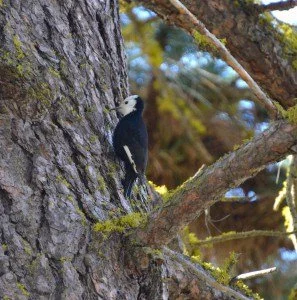Hi Fireshed Community,
As we all know, the forest is home to more than just our human communities. These cold winter months when we spend more time at home provide a great opportunity to learn about how we might improve the balance between wildfire management and wildlife management. This is complex and there is no silver bullet to managing wildfire in a way that supports all species in a positive way. There will always be winners and losers with any type of management action — even when we take no action.
This Wildfire Wednesdays will provide some resources for you to better understand the effects of wildfire and wildfire risk reduction treatments, such as thinning and RX Fire, on wildlife.
This newsletter includes:
An overview of the effects of wildfire on wildlife from The Wildlife Professional
A New Mexico-Specific Science Synthesis of Forest and Woodland Treatment Effects on Wildlife
Upcoming and recorded webinars related to fire and wildlife
Stay safe,
Gabe
Wildfire! Toward Understanding Its Effects on Wildlife — from The Wildlife Professional
Wildlife professionals know many North American ecosystems are fire-adapted and require fire to shape their structures, functions and processes, which in turn shape wildlife habitats and populations in important ways. Over the past century, however, synergistic effects of fire exclusion, livestock grazing, timber harvest and land development have led to conditions where many wildfires are larger and burn with greater intensity and severity than they did in the past.
To better understand the overarching effects of wildfire on wildlife species, read this article from The Wildlife Professional.
Assessment of Forest and Woodland Treatment Effects on Wildlife
In 2019, the New Mexico Department of Game and Fish worked with the Forest Stewards Guild to complete a science synthesis of the effects of forest and woodland treatments on wildlife species. This guide is helpful to understanding how wildfire risk reduction treatments through thinning and prescribed fire may effect various wildlife species in across a range of forest types.
This guide may be useful for New Mexico landowners that want to manage their forest for a particular species of concern. Click here to access the New Mexico science synthesis.
For specific information about the effect of wildfire on birds, check out this Science You Can Use briefing paper titled “Birds and Burns.”
Webinars Related to Wildfire and Wildlife
Upcoming
Fueling Collaboration: Fire and Wildlife
8:00 Pacific / 9:00 Mountain / 10:00 Central / 11:00 Eastern (1.5 hr)
The third panel discussion of season 3 of the “Fueling Collaboration” series from eastern JFSP Fire Science Exchanges and USFS Northern and Southern Research Stations will be moderated by Lauren Pile Knapp (register).
Recorded
The Effects of Prescribed Fire on Wildfire Regimes and Impacts
Presenter: Dr. Molly Hunter, USGS SW Climate Adaptation Science Center, Research Manager / Joint Fire Science Program, Science Advisor
To access the webinar, click here.
Prescribed fire can result in significant benefits to ecosystems and society. Examples include improved wildlife habitat, enhanced biodiversity, reduced threat of destructive wildfire, and enhanced ecosystem resilience. Prescribed fire can also come with costs, such as reduced air quality and impacts to fire sensitive species. To plan for appropriate use of prescribed fire, managers need information on the tradeoffs between prescribed fire and wildfire regimes.
Science and Management of Wildfire, Fish, and Water Resources in the Western US
Presenter: Dr. Patrick Belmont, Utah State University
To access the webinar, click here.
Wildfire has increased 20-fold in the last 30 years in the Western U.S., partly due to climate change and partly due to forest and fire management practices. At the same time, many water resources are drying up. And fish populations throughout the western US are struggling due to water diversions, instream barriers, invasive species, and dwindling flows. This talk integrated across these three big, converging problems, reframing the role of wildfire in western ecosystems, discussing how wildfire, fish, and water resource problems are interrelated, and proposing solutions that match the scale of the problem.


